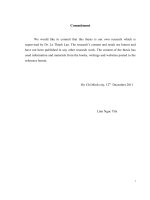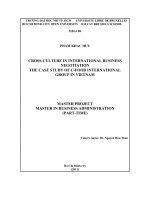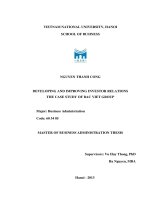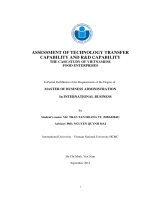Crossculture in international business negotiation the case study of C food international group in Vietnam
Bạn đang xem bản rút gọn của tài liệu. Xem và tải ngay bản đầy đủ của tài liệu tại đây (1.09 MB, 63 trang )
TRNG I HC M TP. HCM UNIVERSITE LIBRE DE BRUXELLES
HO CHI MINH CITY OPEN UNIVERSITY SOLVAY BRUSSELS SCHOOL
MBAVB4
PHAM KHAC HUY
CROSS-CULTURE IN INTERNATIONAL BUSINESS
NEGOTIATION
THE CASE STUDY OF C-FOOD INTERNATIONAL
GROUP IN VIETNAM
MASTER PROJECT
MASTER IN BUSINESS ADMINISTRATION
(PART-TIME)
Tutor’s name: Dr. Nguyen Huu Than
Ho Chi Minh city
(2011)
ii
DECLARATION AND CONFIDENTIALITY
I confirm that this thesis is a presentation of my original research work which I
have studied and researched. Wherever contributions of others are involved, every
effort is made to indicate this clearly, with due reference to the literature, and
acknowledgement of collaborative reseach and discussions.
This work is done for the study purpose. Copying or using this paper for any other
purpose must be subject to the written acceptance of the author.
Pham Khac Huy
iii
Acknowledgement
This project would not have been done without the contribution and
encouragement from many people.
First of all, I would like to express my grateful thanks to my supervisor, Dr.
Nguyen Huu Than, for his valuable guidance, advice and recommendations during
the study.
I am also grateful for the help and contributions from the Purchasing Manager,
Mr. Maher Arayssi. Without his help and contributions, this study would not have
been done successfully.
I would like to express my deep gratitude to my colleagues, Ms Nguyen Thi Mai
Khoi and Ms Nguyen Thi Hong Xuan, who shared their intensive understanding
and experience about C-Food.
I am in my parents’ and my grandparent’s debts for their continual supports
spiritually and financially.
Finally, I would like to thank the members of the Board of Jury for spending time
examining and giving valuable comments to improve this study.
HCM city, February, 2012
PHAM KHAC HUY
iv
ABSTRACT
At the age of globalization, cross-country business has now been emerging as a
new trend worldwide. In this new trend, cross-culture negotiation play a vital role.
Understanding this vital role will facilitate companies doing business
internationally. The more you understand cross-culture negotiation, the greater
your chance of success will be. In Vietnam, more and more companies are
involving themselves into cross-country business in general and cross-culture
negotiation in particular. However, there have been few studies about cross-culture
negotiation. For this reason, the study was conducted to get a better understanding
of the new term ‘cross-culture negotiation’.
The scope of the study is the business cooperation among C-Food International
group –C-Food in short, a Lebanese located company – and its Vietnamese
seafood suppliers. Vora’s twelve cultural variable model
1
was used in the study to
examine the case. Another nine factors obtained by the author from his actual
working experience at C-Food were also used. The study was begun with in-depth
interiew. The interviewee was the Purchasing Manager of C-Food. The aim of this
qualitative research was to get the viewpoints of C-Food about its Vietnamese
partners in negotiation. These viewpoints were served as a base to structure
questionnaire which would be sent to Vietnamese suppliers to their viewpoints
about C-Food in negotiation. 9 out of 14 suppliers responded, accounting for 64%.
The next step is telephone interview. Phone calls were made to reconfirm the
answer of these nine suppliers. Finally, C-Food’s viewpoints and Vietnamese ones
were compared to describe the differences in negotiation between two sides.
1
Vora, D. (2001), Notes from lectures, University of South Carolina, Columbia, US.
TABLE OF CONTENT
INTRODUCTION
RATIONALE OF THE STUDY
RESEARCH PROBLEM
STATEMENT OF THE PROBLEM
THE OBJECTIVES OF THE STUDY
RESEARCH MODEL
RESEARCH METHODOLOGY
SCOPE AND LIMITATIONS OF THE STUDY
STRUCTUE OF THE STUDY
1. CHAPTER 1: LITERATURE REVIEW
1.1. CULTURE
1.1.1. ELEMENTS OF CULTURE
1.1.2. HOFSTEDE’S DIMENSIONS OF CULTURE
1.1.3. HIGH CONTEXT VERSUS LOW CONTEXT CULTURES
1.2. ORGANIZATIONAL CULTURE
1.3. NEGOTIATION
1.3.1. DEFINITIONS OF CULTURE
1.3.2. NEGOTIATION STYLES
1.3.2.1. PRICE NEGOTIATION
1.4. CROSS-CULTURE NEGOTIATION
1.4.1. CROSS-CULTRE NEGOTIATION
1.4.2. INTERNATIONAL NEGOTIATION PROCESS
1.4.3. POSSIBLE PROBLEMS IN CROSS-CULTURE NEGOTIATION
2. CHAPTER 2: INTRODUCTION TO C-FOOD INTERNATIONAL GROUP
2.1. PRODUCTS AND SERVICE
2.2. BUSINESS PERFORMANCE
2.3. PROBLEMS IN NEGOTION PROCESS
3. CHAPTER 3: RESEARCH METHODOLOGY
3.1. RESEARCH MODEL
3.2. RESEARCH PROCESS
3.3. RESEARCH METHOD
3.3.1. QUALITATIVE RESEARCH
3.3.2. QUANTITATIVE RESEARCH
4. CHAPTER 4: RESEARCH FINDINGS
4.1. NEGOTIATION PROCESS BETWEEN C-FOOD AND ITS PARTNERS
4.2. RESEARCH FINDINGS
5. CHAPTER 5: DISCUSSION AND RECOMMENDATIONS TO CROSS-
CULTURE BUSINESS NEGOTIATION
CONCLUSION
CONCLUSION
LIMITATION AND SUGGESTION
LIST OF FIGURE
Figure 1: Coordinating mechanism 22
Figure 2: Research model 24
Figure 3: Research process 25
Figure 4: Negotiation process 27
ABBREVIATIONS
EU: European Union
FCL: Full Container Load
GCC: Gulf Cooperation Council
HACCP: Hazard Analysis and Critical Control Points
LC: Letter of Credit
LCL: Less than Container Load
NAFIQAD: National Agro – Forestry – Fisheries Quality Assurance Department
TT: Telegraphic Transfer
VCCI: Vietnam Chamber of Commerce and Industry
1
INTRODUCTION
RATIONALE OF THE STUDY
Before considering the worthiness of conducting the study, we should revisit some
main concepts and literature related to cross-culture negotiation. The first one is
negotiation. Negotiation is the process by which at least two parties try to reach an
agreement on matters of mutual interest
1
. Negotiations occur in all societies, and on all
levels between various parties in various situations. These situations can be of a social,
economic or political art. Individuals, companies, ethic groups and nations have
always used negotiations as a way to try to satisfy their basic needs
2
. The second one
is cross-culture negotiation. Conducting business and negotiating in one’s culture can
be complicated tasks, but these tasks are more complex when they are conducted
across cultures. Negotiating styles that work within one culture often do not work
within a different culture and because of this, business negotiators working in foreign
cultures have a complex task to manage
3
. Therefore, culture definitely has a major
impact on negotiation styles
4
. Culture is also one of the most challenging elements of
the international marketplace. The influence of the culture diversity on international
business negotiation will continue to increase in importance as a result of the
liberalization of markets worldwide and cross-border mergers and acquisition
5
.
1
Gulbro, R. & Herbig, P. (1996), Cross-cultural negotiating process, Industrial Management & Data Systems
Volume 96 Number 3 1996 pp. 17-23, MCB University Press.
2
Nilsson Molnar, 1997, extracted from Johan Lintzen & Anne Svedjehlm (2006), The Impact of Culture on
Business Negotiations between Swedish and US Businessmen: A Case Study of Two Swedish Businessmen,
pp.6, Master Thesis, Lulea University of Technology.
3
Rodriguez, C. (2001), International Management: Cultural Approach, 2
nd
edition, Cincinnati, Ohio: South-
Western College Publishing extracted from Johan Lintzen & Anne Svedjehlm (2006), The Impact of Culture on
Business Negotiations between Swedish and US Businessmen: A Case Study of Two Swedish Businessmen, Master
Thesis, Lulea University of Technology pp. 2.
4
Zoubir, Y.H. (2003), International Negotiations: A Professional’s Approach Interview with Mr. Josep
Chriqui, Senior Vice President, Alstom Power Turbo-Systems, Thunderbird International Business Review;
Nov-Dec 2003, Vol. 45 Issue 6, p695, 6p.
5
Czinkota, M.R. & Ronkainen, I.A. (1998), International Marketing, Orlando: The Dryden Press extracted from Johan
Lintzen & Anne Svedjehlm (2006), The Impact of Culture on Business Negotiations between Swedish and US
Businessmen: A Case Study of Two Swedish Businessmen, Master Thesis, Lulea University of Technology, pp. 1.
2
At this age of globalizaiton, cross-country business has become a common trend for
any company involving international business. In this business trend, cross-culture
business negotiation plays a vital role. Companies doing business internationally
cannot be sucessful without realizing this vital role. In Vietnam, more and more
companies are involving themselves in this cross-country business process. However,
there have been few studies conducted by scholars or economists on this process
especially for cross-culture business negotiation with Islamic partners. Moreover, most
of Vietnamese enterprises do not pay much attention to this aspect in their business
either.
For the said-above reasons, conducting a study on cross-culture negotiation between
C-Food and Vietnamese suppliers is worth doing because both sides are involving
themselves in this international business process. The research problem will be stated
in the next section.
RESEARCH PROBLEM
It is worth going through the brief introduction of C-Food International group,
hereinafter called C-Food, before we consider the problem. It was founded in 2003 in
Lebanon, an Islamic country in Middle East. In 2004, the branch in Ho Chi Minh city
was established. C-Food is a seafood trading company in Middle East, Africa and
Eastern Europe. It is the market leader in these areas. Until now, it has a distribution
network covering 27 countries
6
.
C-Food has a wide range of seafood products ranging from the farmed-raised to wild-
caught shrimps and fish. More than 70% of its products are being bought from
Vietnam to export to its markets. Despite of being a creditable account and having
cooperated with these Vietnamese suppliers since 2004, C-Food is still facing
6
www.c-food.info, www.siblou.com
3
difficulties in negotiating with them. For the newly-cooperated suppliers, the
difficulties are becoming tougher and tougher. These difficulties strongly are strongly
affecting the efficiency of C-Food’s supply chain.
STATEMENT OF PROBLEM
As a trading company, negotiating to purchase goods for its distribution network is
vitally important for C-Food. Moreover, C-Food is pursuiting both expanding the
distribution network and deeply exploiting its current market share. In such
circumstances, the negotiation process is taking more and more time to be done. Mails
requesting for price quotation are being replied late. Whenever a mail requesting for
quotation is sent by C-Food’s Purchasing Manager, colleagues in Vietnam branch have
to call the related suppliers to remind the latter of answering. The Vietnamese
colleagues sometimes have to make several phone calls to guarantee that any price
requesting mail will be responded.
Moreover, the suppliers’ process of handling the orders placed by C-Food has not been
done in line with C-Food’s distributing process. Shipments are being delayed
dramatically, which not only damages C-Food’s reputation but also costs C-Food’s
money to deal with the results of shipment delaying. Such sluggishness has negatively
affected the overall performance of C-Food.
Except for the economic reasons, the project would aim at identifying cultural
elements which affect the negotiation process. Once the elements are discovered, the
project will try to provide some remedies for minimizing the negative effects of these
elements.
THE OBJECTIVES OF THE STUDY
Research objectives:
The problem to be raised in this research is
• To evaluate how cultural differences cause the ineffectiveness in negotiation
4
• To suggest the measures to reduce the effects of the causes
Research questions:
• How do cultural differences affect business negotiation?
• How to reduce the effects of the cultural differences
RESEARCH MODEL
The twelve main variables
7
influencing cross-culture negotiation of Vora were taken
into consideration in five steps of negotiation process, i.e. the offer, informal meeting,
strategy formulation, negotiation and implementation
8
. These variables were:
1. Basic conception of the negotiation process – strategic versus synergistic
2. Negotiator selection criteria
3. Significance of types of issues – substantive versus relation
4. Concern with protocol – formal versus informal
5. Complexity of the language – high context versus low context
6. Nature of persuasive argumentation – emotional versus logical
7. Role of individuals’ aspirations
8. Bases of trust – cognitive versus affective
9. Risk-taking propensity – high versus low
10. Value of time – monochronic versus polychronic
11. Decision-making system – authoritative versus consensual
7
Vora, D. (2001), Notes from lectures, University of South Carolina, Columbia, US.
8
Czinkota, M.R. & Ronkainen, I.A. (1998), International Marketing, Orlando: The Dryden Press extracted from Johan
Lintzen & Anne Svedjehlm (2006), The Impact of Culture on Business Negotiations between Swedish and US
Businessmen: A Case Study of Two Swedish Businessmen, Master Thesis, Lulea University of Technology pp. 11.
5
12. Form of satisfactory agreement – written versus oral
Moreover, the legal regulations of Vietnam and C-Food’s clients’ countries, religion as
well as the practices of doing business of C-Food were also examined in this research.
RESEARCH METHODOLOGY
The research was started with an in-depth interview. The interviewee was C-Food’s
Purchasing Manager. The aim of this interview was to get an inside view of the
difficulties faced by C-Food side. And the results of the interview would be served as
the base to construct the questionnaire for the email survey stage.
Next, email survey was conducted. The questionnaire for email survey would be
designed by comparing the viewpoints of C-Food’s Purchasing Manager with those of
C-Food’s suppliers’. The receivers of the questionnaire were import – export
managers, sales managers or deputy sales managers. Moreover, open-ended questions
were also used in the email survey to get deeper understandings about the suppliers’
thinking. By comparing two sources of comments, the actually causes for preventing
effective negotiations would be drawn.
After that, telephone interview was carried out with each supplier. The purpose of this
method was to reconfirm what had been answered by the suppliers as well as to clarify
the unclear points in the answered forms.
During study, observation was also employed to discover things that cannot be found
in previous methods.
SCOPE AND LIMITATIONS OF THE STUDY
Cross-culture business negotiation is a large field of study. In this project, the study is
confined in the business cooperation between C-Food and its Vietnamese suppliers. In
other words, the study focuses on the business relationship of C-Food and its
Vietnamese partners. Another issue is the willingness to respond of the respondents –
6
Vietnamese suppliers. Vietnamese people in general and suppliers in particular tend to
be not so straightforward. Hence, there may be a risk mis-interpretation of the data
collected.
STRUCTURE OF THE STUDY
Introduction
Chapter 1:
Literature review provides the knowledge of recent studies on culture, organizational
culture, business negotiation and the possible problems in cross-culture business
negotiation.
Chapter 2:
Brief description of C-Food’s products, services and performance will be introduced.
And the problems with C-Food’s business negotiation will be stated in this chapter.
Chapter 3:
Research methodology describes the research model, research process, and research
methods.
Chapter 4:
Findings of the research will be presented and analyzed.
Chapter 5:
Discussion and recommendations to cross-culture business negotiation
will be presented.
Conclusion
7
CHAPTER 1: LITERATURE REVIEW
In this chapter, some definitions of culture, negotiation and cross-culture negotiation
will be revisited.
1.1 CULTURE
Culture can be defined as “complex whole which includes knowledge, belief, art,
morals, laws, custom, and any other capabilities and habits acquired by a man as a
member of a society”. It includes everything that people have, think and do as
members of a society
9
. According to Czinkota & Ronkainen (1998), all definitions of
culture agree on that culture is learnt, shared, and transmitted from one generation to
the next. “Culture is primarily passed on from parents to their children but also by
social organizations, special interest groups, the government, the schools, and the
church.”
10
Trompenaars et al., (1997) have written a memorable description about culture: “A
fish only discovers its need for water when it is no longer in it. Our own culture is like
water to a fish. It sustains us. We live and breathe through it. What one culture may
regard as essential, a certain level of material wealth for example, may not be so vital
to other cultures.”
11
1.1.1 Elements of Culture
Czinkota & Ronkainen (1998) claim that culture consists of common elements that
interdependent
12
. They are
9
Francesco, A.M & Gold, B.A. (1998), International Organizational Behavior: Text readings, cases, and
skills, London: Prentice-Hall International Limited .
10
Czinkota, M.R. & Ronkainen, I.A. (1998), International Marketing, Orlando: The Dryden Pressextracted from Johan
Lintzen & Anne Svedjehlm (2006), The Impact of Culture on Business Negotiations between Swedish and US
Businessmen: A Case Study of Two Swedish Businessmen, Master Thesis, Lulea University of Technology.
11
Trompenaars, F. (1997), Riding the Waves of Culture: Understanding Cultural Diversity in Business, pp.20
London: Breadly.
12
Czinkota, M.R. & Ronkainen, I.A. (1998), International Marketing, Orlando: The Dryden Pressextracted from Johan
Lintzen & Anne Svedjehlm (2006), The Impact of Culture on Business Negotiations between Swedish and US
8
Language
Language is a multidimensional element of culture that can be divided into verbal
language and non-verbal language. Verbal language is about what words are used and
how they are pronounced. Language has the capability to convey different meanings to
different people. Non-verbal language is about the relation people have to time, space,
material possessions, friendship patterns, and business agreements which are important
parts of non-verbal language. For example, in some parts of the world time is seen as
flexible and coming late to an appointment is acceptable whereas in other countries
this is considered extremely impolite.
Religion
Religion defines the ideals for life, and these are reflected in the values and attitudes of
individuals and societies. The behavior and practices of institutions and members of
cultures are then shaped by the values and attitudes that individuals and groups of
people have. Religion thus affects international business, but the size of impact
depends on how strong the dominant religions in the culture in the question are.
Values and Attitudes
Shared beliefs or group norms that have been internalized by individuals are known as
values. An attitude is a person’s evaluation of alternatives based on his/her values. One
has to be more careful about one’s approach in a foreign culture.
Manners and Customs
It is very important to understand manners and customs in negotiations, as all types of
communication should be read correctly in order to negotiate effectively. If a person
only uses his or her own frame of reference to interpret behavior of other people, he or
she may come to a totally wrong decision.
Businessmen: A Case Study of Two Swedish Businessmen, Master Thesis, Lulea University of Technology.
9
Material Elements
Technology forms what is known as material culture. This element of culture is related
to how the economic activities of a society are organized. The economic activities are
expressed in the form of availability and adequacy of basic economic, social, financial
and marketing infrastructures.
Aesthetics
Color forms and music as well as the arts are used by a culture to express what it
considers to be good taste. Colors are often used for brand identification, feature
reinforcement, and differentiation.
Education
How culture is passed on and shared, is to a large extent affected by both informal and
formal education. It is important for international firms to be familiar with the extent
to which a culture emphasizes on particular skills and the overall level of education.
1.1.2 Hofstede’s dimensions of culture
In the late In the late 1970s Geert Hofstede conducted a survey over 40 countries in
which IBM had its affiliates to develop the so-called four dimensions culture. They
areconducted a survey over 40 countries in which IBM had its affiliates to develop the
so-called four dimensions culture. They are power distance index, uncertainty
avoidance index, individualism and masculinity.
13
Power distance index (PDI)
Power distance refers to the extent to which the members of a nation are willing to
accept an unequal distribution of power, weath and prestige. Lower distance
13
Mary Jo Hatch, 1997. Organization Theory: Modern, Symbolic and Postmodern Perspective p.206-210 Oxford
University Press.
10
characterizes countries, like Denmark, where such inequalities are difficult to accept.
Uncertainty Avoidance Index (UAI)
Uncertainty avoidance involves the ways in which human societies have learned to
cope with uncertainty. In low uncertainty cultures people are more of accepting
innovative ideas and eccentric or deviant behavior, whereas in high uncertainty
avoidance cultures, these are resisted. Hofsted finds that uncertainty avoidance is high
in Greece, Portugal, and Japan, while it is low is in Singapore, Hongkong, and
Sweeden.
Individualism (IDV)
Individualism involves the degree to which individuals in a culture are expected to act
independently of other members of the society. Relationships between members of
individualistic culture are loose and individuals are expected to take care of
themselves. By contrast, in collectivist culture, cohesive groups give individuals their
sense of identity and belonging, demanding considerable loyalty in return for the sense
of security that they impart. Hofstede points out that, in some cultures such as the US,
individualism is seen as a source of well-being, whereas in others like Chinese or
Mexican cultures, it is seen as undesirable and alienating.
Masculinity (MAS)
Masculinity refers to the clear separation of gender roles in society. In highly
masculine cultures, men are expected to be more assertive and women more nurturing.
In cultures that score low on the masculinity dimension, these gender differences are
less pronounced. Hofstede further found out that highly masculine cultures tend to
place more emphasis on work goals having to do with career advancement and
earnings, whereas less masculine cultures favored work goals concerning interpersonal
relationships, service, and the physical environment.
11
Research by Michael Bond and colleagues among students in 23 countries led him in
1991 to adding a fifth dimension called Long- versus Short-Term Orientation. In 2010,
research by Michael Minkov allowed to extend the number of country scores for this
dimension to 93, using recent World Values Survey data from representative samples
of national populations.
14
Long-term orientation
Long- term oriented societies foster pragmatic virtues oriented towards future rewards,
in particular saving, persistence, and adapting to changing circumstances. Short-term
oriented societies foster virtues related to the past and present such as national pride,
respect for tradition, preservation of "face", and fulfilling social obligations.
15
1.1.3 High context cultures versus low context cultures
A society that uses a lot of non-verbal signals is said to be a highly complex one that is
high context in nature. The difference between high context cultures and low context
cultures is in the amount of information conveyed by words or by body language. In a
high context culture the context is at least important as what is actually said. In a low
context culture most of the information is carried out in the spoken words. However, it
is not always obvious how to classify high or low context cultures. It is easy to
characterize those cultures where gestures and body languages are used extensively as
high context cultures and those cultures where body language is almost invisible as
low context cultures, and this classification is not always correctly done. If one is not
aware of the basic difference between high context cultures and low context cultures,
messages and intentions can easily be misunderstood.
16
1.2 ORGANIZATIONAL CULTURE
14
15
16
Winters, E. (2000), Across the Pacific pond: A very personal view of Japanese, Chinese, and North America
bargaining environment.
12
Elliott Jaques (1952: 251) defines the culture of the factory is its customary and
traditional way of thinking and doing things, which is shared to a greater or lesser
degree by all its members, and which new members must learn, and at least partially
accept, in order to be accepted into service in the firm.
17
1.3 NEGOTIATION
1.3.1 Definitions of negotiation
Nilsson Molnar (1997) claims that negotiations occur in all societies, and on all levels
between various parties in various situations. These situations can be of a social,
economic or political art
18
. Deresky (2000) defines negotiation as “the process of
discussion between two or more parties aimed at reaching a mutually acceptable
agreement”
19
. In Winning Negotiations That Preserve Relationships, Harvard Business
School Press, 2004. Series HD58.6.W566 2004, negotiation isn’t about outwitting or
taking advantage of others. It’s about arriving at a shared solution to a problem – a
solution that benefits all parties involved. It’s also about a lot more than just getting
the best possible price on a deal. The most effective negotiations result in mutually
beneficial, enduring relationships in which the parties trust one another and share
expectations about how their deals will work out in practice as well as on paper.
1.3.2 Negotiation styles
Holley et al., (2005) claim that there are 5 styles of negotiation
20
.
17
Mary Jo Hatch, 1997. Organization Theory: Modern, Symbolic and Postmodern Perspective p.205 Oxford
University Press.
18
Nilsson Molnar, 1997, extracted from Johan Lintzen & Anne Svedjehlm (2006), The Impact of Culture on
Business Negotiations between Swedish and US Businessmen: A Case Study of Two Swedish Businessmen,
p.2, Master Thesis, Lulea University of Technology.
19
Deresky, H. (2000), International Management: Managing Across Borders and Cultures, p.168 New
Jersey: Prentice Hall Inc.
20
Holley, et al (2005) extracted from Arazi Idrus, Azzuin Amer, & Chritiono Utomo (2007), A Study of
Negotiation Styles in Malaysian Construction Industry, p.1 & 2 Civil Engineering Department, Universiti
Teknologi PETRONAS 31750 Tronoh, Perak, Malaysia.
13
Collaborating
Acting with high concern for self and others with the objective of achieving an
outcome that satisfies both parties requires collaboration and open exchange of
information. The nature the integrating style, therefore, is one of being both assertive
and cooperative. It follows a mixture of tactics is employed in the integrating style, as
resolution needs identifying and analyzing the various differences between the parties
and the exploration of new solutions.
Accommodating
Being unassertive and cooperative indicates the accommodating style, where the
outcome is a lose-win situation. Here, a person acts with low concern for self and a
high concern for others, emphasizing shared aims and de-emphasizing differences.
Competing
A person whose actions in a conflict situation are determined by a high regard for self
and a low concern for others (being assertive and uncooperative) is considered to be
using a competing (dominating) style.
Compromising
A give-and-take attitude demonstrating an intermediate level of concern for self and
others denotes the compromising style, where assertiveness and cooperation are both
present, but in a diluted form.
Avoiding
The avoiding style is unlikely to resolve the conflict in a negotiation. Its elements are
that of having a low concern for self and low concern for others. In this style, the
player is both unassertive and uncooperative and exhibits the attitude of being
unwilling to deal with the issue at hand.
1.3.2.1 Price negotiation
According to oàn Th Hng Vân et al (2009), there are four types of buyers in price
14
negotiation. They are price, relationship, value, and convenient buyers.
21
Price buyers
They are big corporations and governmental bodies who have broad relationship with
other companies as well as have many alternatives. They accept the lowest price with
acceptable goods quality. In negotiation with these buyers, suppliers should draw the
buyers’ attention to uniqueness of the goods or service to increase the willingness to
buy of the buyers. In case the suppliers cannot convince these buyers, “selection
participation” strategy should be used. In other words, the suppliers have to take in
consideration the benefits in short-term and long-term, and only accept the buyers’
counter-offer on condition that profitability is guaranteed and that future operation of
the company will not be affected by this acceptance.
Relationship buyers
These buyers are on the contrary to the price buyers. They value the quality of the
goods or service and have confidence in the suppliers. They do not want to try a new
alternative. For these buyers, maintaining the existing relationship by reminding the
past performance is critical. The attitude in negotiation with this group should be open
and focus on the mutual benefits.
Value buyers
They do not find out either the highest quality goods or service or the cheapest ones.
Instead, they decide to buy after considering the quality of the goods or service and
evaluating the relationship between the quality and the price of goods or service. These
buyers are aware of the quality for each option for each price. Unlike the price buyers
who focus only on price, value buyers take into consideration the cost of marginal
21
òan Th Hng Vân, Kim Ngc t (2009), àm phán trong kinh doanh quc t, p.250-252 NXB Lao
đng – Xã hi.
15
satisfaction. Therefore, they accept high price for high quality goods or service. With
these buyers, the sellers can make a big profit if they can well communicate the
superior quality of their goods or service to the buyers. However, these buyers always
have their own alternatives.
Convenient buyers
This group of buyers only appears in a special circumstance. Negotiators of this group
focus only on the convenience. They do not pay much attention to comparing the cost,
price, and quality of the goods or service. They belong to the so-called “let’s get it
done” type of negotiators who would like to close a negotiation as soon as possible.
It is noticed that the negotiators of this group are not careless at al although they prefer
a fast-ending deal. They understand so well what they are doing. In some case, these
negotiators take the advantage of “let’s get it done” to get a deal in favor of them.
Therefore, the sellers should not hurriedly close a deal with these buyers.
1.4 CROSS-CULTURE IN BUSINESS NEGOTIATION
1.4.1 Cross-culture negotiation
According to Adler (1986) a negotiation becomes cross-cultural when the parties
involved belong to different cultures and therefore do not share the same way of
thinking, feeling and behaving
22
. Rodriguez (2001) claims that negotiations including
two or more cultures are far more complicated than negotiation within a culture,
because the negotiators simultaneously have to take both different styles of negotiating
and cultural variables into consideration.
23
1.4.2 International negotiation process
22
Adler (1986) extracted from Johan Lintzen & Anne Svedjehlm (2006), The Impact of Culture on
Business Negotiations between Swedish and US Businessmen: A Case Study of Two Swedish Businessmen,
p.5 Master Thesis, Lulea University of Technology.
23
Rodriguez (2001) extracted from Johan Lintzen & Anne Svedjehlm (2006), The Impact of Culture
on Business Negotiations between Swedish and US Businessmen: A Case Study of Two Swedish
Businessmen, p.2 Master Thesis, Lulea University of Technology.
16
According to Gulbro & Herbig (1995), the classical view of the cross-culture
negotiation process undergoes four stages: non-task, task, persuasion and agreement.
24
Non-task sounding
This stage includes all those activities which might be described as establishing a
rapport or getting to know one another, but does not include information related the
business of the meeting.
Task
It concerns the information exchanged regarding to the parties’ needs and preferences
of parties.
Persuasion phase and compromise
The third stage focuses on efforts to modify the views of other parties and sway them
to our way of thinking through the use of various persuasive techniques. Persuasion is
typically used to compromise on certain conditions so that the two sides can close a
deal. If not handled properly, failure becomes almost certain.
Concessions and agreement
The final stage is the culmination of the negotiating process at which an agreement is
reached.
To reach an agreement that is mutually acceptable, each side must frequently give up
something. Therefore, concessions by both sides are usually necessary to reach an
agreement.
Czinkota & Ronkainen (1998) argue that the international negotiation process can be
divided into five steps. They are the offer, informal meetings, strategy formulation,
24
Gulbro & Herbig (1995) extracted from Johan Lintzen & Anne Svedjehlm (2006), The Impact of
Culture on Business Negotiations between Swedish and US Businessmen: A Case Study of Two Swedish
Businessmen, p.9 Master Thesis, Lulea University of Technology.
17
negotiations, and implementation. Which step is most important and how long it takes
is strongly affected by which culture the negotiators come from.
25
The offer
The first stage allows the parties to analyze each other’s needs and degree of
commitment. The initiation and development of the process to a high degree
determined by the background factors (such as goals) of the involved parties, and by
the general atmosphere.
Informal meeting
After the buying party has received the offer, the parties meet to discuss the terms and
get to know each other, i.e. informal meetings. In many parts of the world negotiations
fail because the informal meeting was a disappointment for one or both the parties. In
some cultures, business people like to be assured of that the people they are going to
do business with are sympathetic and trustworthy. In some cases, it is necessary to hire
consultants in order to establish contact with the other side.
Strategy formulation
Both parties have to formulate strategies for formal negotiations. This means not only
careful review and assessment of all the factors affecting the deal to be negotiated but
also preparation for the actual give-and-take of negotiation.
Negotiations
The actual face-to-face negotiations and the approach used in them will depend on the
cultural background and business traditions prevailing different countries.
Implementation
25
Czinkota, M.R. & Ronkainen, I.A. (1998), International Marketing, Orlando: The Dryden Press extracted from Johan
Lintzen & Anne Svedjehlm (2006), The Impact of Culture on Business Negotiations between Swedish and US
Businessmen: A Case Study of Two Swedish Businessmen, Master Thesis, Lulea University of Technology.
18
The final step in negotiation process is the implementation.
According to Czinkota & Ronkainen (1998) the negotiation process often varies
between cultures and international business negotiators therefore have to adapt the
way they make contact, exchange information, persuade, and make concessions, to the
culture they operate in.
1.4.3 Possible problems in cross-culture negotiation
Lewis (1999) says that problems in cross-culture negotiations derive from two sources:
the professionalism of the negotiation team, and cross-culture bias. Usually negotiating
teams of companies do not consist of professional or trained negotiators. This is
especially apparent in small and medium-sized firms. The often send the same people
that handle the company’s domestically, to negotiate with people from other cultures.
If the negotiators completely lack foreign experience, they may have large difficulties
understanding the logic, intent and ethical standpoints of the other side.
26
According to Rodriguez (2001), people who are negotiating in an unfamiliar culture
often do reach the goals the had set up, either because they have not learned how to
adjust to the other culture or because the other side has taken more time trying to learn
how the obstacles that can normally be associated with international negotiations. He
also claims that a company will most probably not be successful in another culture if it
lacks understanding of and or disregard the cultural variables.
27
According to Czinkota & Ronkainen (1998), culture is one of the most challenging
elements of the international marketplace. Cultural differences that might cause
problems in the communication between business partners is a major consideration for
companies since cultural clashes are often underlying motivations for failure in many
26
Lewis, R.D. (1996), When cultures collide: Manging Successfully Across Cultures, London: Nicholas
Breadly Publihsing.
27
Rodriguez, C. (2001), International Management: Cultural Approach, 2
nd
edition, Cincinnati, Ohio:
South-Western College Publishing.









